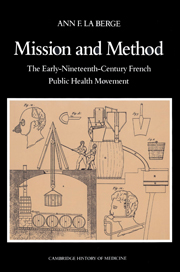Book contents
- Frontmatter
- Contents
- List of tables and illustrations
- Preface
- Acknowledgments
- Introduction
- I Community, method, context
- Chapter 1 Public health and the community of hygienists
- Chapter 2 The methodology of public hygiene
- Chapter 3 The context of public hygiene: National public health policy
- II Carrying out the mission: Institutionalization, investigation, moralization, and practical reform
- III Public health before Pasteur
- Epilogue
- Appendixes
- Bibliographical Note
- Index
Chapter 1 - Public health and the community of hygienists
Published online by Cambridge University Press: 17 September 2009
- Frontmatter
- Contents
- List of tables and illustrations
- Preface
- Acknowledgments
- Introduction
- I Community, method, context
- Chapter 1 Public health and the community of hygienists
- Chapter 2 The methodology of public hygiene
- Chapter 3 The context of public hygiene: National public health policy
- II Carrying out the mission: Institutionalization, investigation, moralization, and practical reform
- III Public health before Pasteur
- Epilogue
- Appendixes
- Bibliographical Note
- Index
Summary
From the fall of the Roman Empire to the late eighteenth century, two kinds of public health measures dominated: emergency measures to deal with epidemic disease and specific measures relating to municipal nuisances such as offensive trades and waste disposal. The principal goal of public health was the prevention and management of epidemics, whose methods varied, but typically included emergency measures such as quarantines, sequestration, cordons sanitaires, and temporary institutions such as boards of health and sanitary intendancies. These measures were predicated upon two theories of disease causation: an environmentalist and climatic theory – the predominant theory – and a contagionist theory. Plague had traditionally been considered a contagious disease, and epidemic prevention and control were based upon that experience. Epidemics posed severe problems for authorities and created a crisis mentality, demanding immediate attention. Once the crisis was over, however, the institutions established to manage the emergency were disbanded, and business as usual resumed. Endemic diseases received little attention from authorities, since they were a way of life and death known to all. There was little concern for permanent public health regulations and institutions in the rural areas and small towns where most people lived. In larger towns and cities, however, local authorities regulated “nuisances,” such as refuse disposal and offensive trades. Enforcement varied widely from place to place, with many regulations not being enforced at all. If a particular situation became too troublesome, ad hoc action was taken.
- Type
- Chapter
- Information
- Mission and MethodThe Early Nineteenth-Century French Public Health Movement, pp. 9 - 48Publisher: Cambridge University PressPrint publication year: 1992



